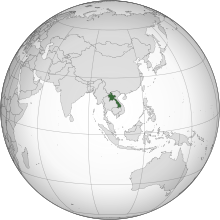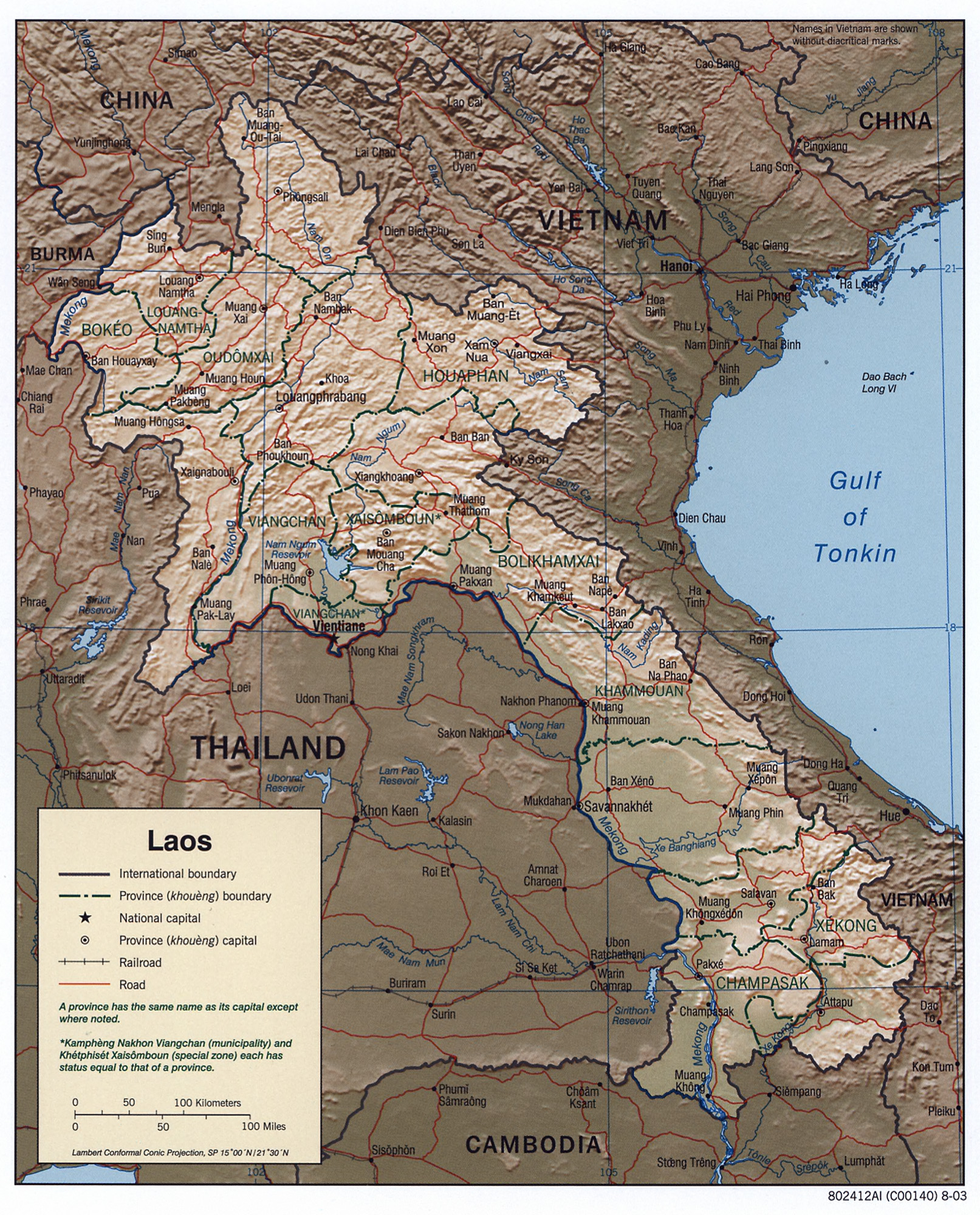Lao People's Democratic Republic: Difference between revisions
More languages
More actions
mNo edit summary Tag: Visual edit |
mNo edit summary Tag: Visual edit |
||
| Line 25: | Line 25: | ||
'''Laos''', officially, the '''Lao People's Democratic Republic (LPRP'''), is a modern-day socialist country, established in Southeast Asia after having achieved independence through its liberation movement led by [[Kaysone Phomvihane]] (a figure analogous to [[Vietnam]]'s [[Ho Chi Minh]]).<ref>{{News citation|journalist=Andre Barahamin|date=2017-11-05|title=The hero of Laos: Kaysone Phomvihane|url=https://rallu.xyz/2017/11/05/the-hero-of-laos-kaysone-phomvihane/}}</ref> | '''Laos''', officially, the '''Lao People's Democratic Republic (LPRP'''), is a modern-day socialist country, established in Southeast Asia after having achieved independence through its liberation movement led by [[Kaysone Phomvihane]] (a figure analogous to [[Vietnam]]'s [[Ho Chi Minh]]).<ref>{{News citation|journalist=Andre Barahamin|date=2017-11-05|title=The hero of Laos: Kaysone Phomvihane|url=https://rallu.xyz/2017/11/05/the-hero-of-laos-kaysone-phomvihane/}}</ref> | ||
The Laotian constitution states that the [[Lao People's Revolutionary Party|LPRP]] | The Laotian constitution states that the [[Lao People's Revolutionary Party|LPRP]] 'is a people’s democratic state' defending 'the interests of the multi-ethnic people of all social strata with the [[Proletariat|workers]], farmers and intelligentsia as key components.'<ref>Constitution of Lao People's Democratic Republic ([https://www.constituteproject.org/constitution/Laos_2003.pdf?lang=en PDF])</ref> | ||
== History == | == History == | ||
| Line 35: | Line 35: | ||
=== Laotian Civil War === | === Laotian Civil War === | ||
The Lao People's Revolutionary Party (LPRP), led by Kaysone Phomvihane and [[Souphanouvong]], waged a war of liberation against the [[Kingdom of Laos (1953–1975)|Kingdom of Laos]] and its allies, including the [[United States of America|United States]]. The three forces in the [[Laotian Civil War]] were the monarchists led by [[Boun Oum]], the [[Liberalism|liberals]] led by [[Souvanna Phouma]], and the communist [[Pathet Lao]].<ref name=":1" /> | The [[Lao People's Revolutionary Party|Lao People's Revolutionary Party (LPRP)]], led by Kaysone Phomvihane and [[Souphanouvong]], waged a war of liberation against the [[Kingdom of Laos (1953–1975)|Kingdom of Laos]] and its allies, including the [[United States of America|United States]]. The three forces in the [[Laotian Civil War]] were the monarchists led by [[Boun Oum]], the [[Liberalism|liberals]] led by [[Souvanna Phouma]], and the communist [[Pathet Lao]].<ref name=":1" /> | ||
During the civil war, the US military dropped 2.5 million tons of bombs on Laos between 1964 and 1973<ref name=":0">{{News citation|newspaper=[[Socialist Voice]]|title=Laos: Building the foundations of socialism|date=2018-05-02|url=https://socialistvoice.ie/2018/05/laos-building-the-foundations-of-socialism/|retrieved=2022-04-23}}</ref>—more than they dropped in all of World War II,<ref>{{News citation|journalist=Ralph McGehee|date=1995-10-09|title=Bombing Laos|url=|newspaper=|archive-url=http://www.hartford-hwp.com/archives/54/057.html|archive-date=|retrieved=2021-12-31}}</ref> killing hundreds of thousands and turning a quarter of Laotians into refugees. 78 million unexploded bombs remained after the war, which still kill or injure 50 civilians every year.<ref>{{News citation|journalist=Rebecca Wright|date=2016-09-06|title='My friends were afraid of me': What 80 million unexploded US bombs did to Laos|url=https://www.cnn.com/2016/09/05/asia/united-states-laos-secret-war/|newspaper=CNN|archive-url=|archive-date=|retrieved=2021-31-21}}</ref> The [[Central Intelligence Agency|CIA]] also spent $500 million training Hmongs to fight on behalf of the monarchy. | During the civil war, the US military dropped 2.5 million tons of bombs on Laos between 1964 and 1973<ref name=":0">{{News citation|newspaper=[[Socialist Voice]]|title=Laos: Building the foundations of socialism|date=2018-05-02|url=https://socialistvoice.ie/2018/05/laos-building-the-foundations-of-socialism/|retrieved=2022-04-23}}</ref>—more than they dropped in all of World War II,<ref>{{News citation|journalist=Ralph McGehee|date=1995-10-09|title=Bombing Laos|url=|newspaper=|archive-url=http://www.hartford-hwp.com/archives/54/057.html|archive-date=|retrieved=2021-12-31}}</ref> killing hundreds of thousands and turning a quarter of Laotians into refugees. 78 million unexploded bombs remained after the war, which still kill or injure 50 civilians every year.<ref>{{News citation|journalist=Rebecca Wright|date=2016-09-06|title='My friends were afraid of me': What 80 million unexploded US bombs did to Laos|url=https://www.cnn.com/2016/09/05/asia/united-states-laos-secret-war/|newspaper=CNN|archive-url=|archive-date=|retrieved=2021-31-21}}</ref> The [[Central Intelligence Agency|CIA]] also spent $500 million training Hmongs to fight on behalf of the monarchy. | ||
Revision as of 20:10, 4 September 2022
| Lao People's Democratic Republic ສາທາລະນະລັດ ປະຊາທິປະໄຕ ປະຊາຊົນລາວ | |
|---|---|
 | |
| Capital and largest city | Vientiane |
| Government | Marxist-Leninist Socialist state |
• President | Thongloun Sisoulith |
• Vice President | Bounthong Chitmany |
• Prime Minister and General Secretary | Phankham Viphavanh |
| History | |
• Establishment of the Lao People's Democratic Republic | 2 December 1975 |
| Population | |
• 2022 estimate | 7,749,595 |
Laos, officially, the Lao People's Democratic Republic (LPRP), is a modern-day socialist country, established in Southeast Asia after having achieved independence through its liberation movement led by Kaysone Phomvihane (a figure analogous to Vietnam's Ho Chi Minh).[1]
The Laotian constitution states that the LPRP 'is a people’s democratic state' defending 'the interests of the multi-ethnic people of all social strata with the workers, farmers and intelligentsia as key components.'[2]
History
French colonization
Before French colonization, Laos existed as the kingdom of Lan Xang Hom Khao. Laos was annexed by the French in 1893 after a war against the Rattanakosin Kingdom in modern-day Thailand. In 1898, Laos was incorporated into French Indochina. The spiritual leaders Ong Keo and Ong Kommandam united Hmong people and and southern hill tribes in the Holy Man's Rebellion against the colonizers.
On 9 March 1945, French Indochina was annexed by fascist Japan. After the Second World War, the Laotian monarchy began to support the independence movement against the French.[3]
Laotian Civil War
The Lao People's Revolutionary Party (LPRP), led by Kaysone Phomvihane and Souphanouvong, waged a war of liberation against the Kingdom of Laos and its allies, including the United States. The three forces in the Laotian Civil War were the monarchists led by Boun Oum, the liberals led by Souvanna Phouma, and the communist Pathet Lao.[3]
During the civil war, the US military dropped 2.5 million tons of bombs on Laos between 1964 and 1973[4]—more than they dropped in all of World War II,[5] killing hundreds of thousands and turning a quarter of Laotians into refugees. 78 million unexploded bombs remained after the war, which still kill or injure 50 civilians every year.[6] The CIA also spent $500 million training Hmongs to fight on behalf of the monarchy.
The United States withdrew from Laos after the Viet Minh's victory in Vietnam in April 1975. In December 1975, the Pathet Lao took power and established a socialist republic in Laos.[3]
Independence
After liberation, Kaysone would dominate Laotian politics until his death in 1992.[7] Laos signed a 25-year friendship treaty with Vietnam in 1977.[3] The First Five-Year Plan began in 1981, but only achieved an economic growth rate of 5% per year. In 1986, Laos began the New Economic Mechanism, based on the New Economic Policy of the USSR.[4] By the end of the Second Five-Year Plan, rice production had doubled and sugar production had increased by 40%.[3]
Economy
The main investors in Laos's economy are China, Vietnam, and the DPRK. Mining takes up 7% of the Laotian economy and includes gold, silver, copper, tin, and potash mines. Industry takes up 28.6% of the economy. Hydroelectric power forms 30% of Laos's exports.
Working hours are limited to 48 hours per week or eight hours per day. Paid sick leave, vacation time, and maternity leave are all provided.[3]
Geography

Laos is a landlocked country and straddled between the tropical monsoon climate which prevails in the Southern half of the country and the temperate and mountainous climate of the North.
Politics
In recent years, the issue of malnutrition is still present in Laos, though the government has made inroads in combating this problem with the help of UNICEF.[8] In addition, Laos has tackled such problems as inequality and poverty in its aim to shed its Least Developed Country Status by 2024. According to the United Nations Development Programme (UNDP), and as The Laotian Times reports, "Lao PDR’s Human Development Index (HDI) value which is calculated based on the life expectancy, level of education and income per capita of a country’s people, has increased by over 50% since 1990."[9] From 1992 to 2008, the poverty rate decreased from 46% to 28%.[4] Laos is also the only ASEAN member to give up luxury state cars in a move by Lao Prime Minister Thongloun Sisoulith to reclaim all Lao leaders' luxury vehicles.[10]
References
- ↑ Andre Barahamin (2017-11-05). "The hero of Laos: Kaysone Phomvihane"
- ↑ Constitution of Lao People's Democratic Republic (PDF)
- ↑ 3.0 3.1 3.2 3.3 3.4 3.5 Morgan Artyukhina (2017-09-22). "Mung Lao: A Portrait of The Lao People’s Democratic Republic" Liberation School. Archived from the original on 2021-03-08. Retrieved 2022-05-22.
- ↑ 4.0 4.1 4.2 "Laos: Building the foundations of socialism" (2018-05-02). Socialist Voice. Retrieved 2022-04-23.
- ↑ Ralph McGehee (1995-10-09). Bombing Laos Archived from the original. Retrieved 2021-12-31.
- ↑ Rebecca Wright (2016-09-06). "'My friends were afraid of me': What 80 million unexploded US bombs did to Laos" CNN. Retrieved 2021-31-21.
- ↑ Andrew Nette (1996-03-27). "LAOS: Kaysone – Big in Life, Bigger in Death"
- ↑ (October 19, 2018) https://laotiantimes.com/2018/10/19/nutrition-kids-unicef-xepon-laos/
- ↑ (October 30, 2018) Inequality, Disasters Risks to Development as Progress Pushed in Laos: UNDP
- ↑ Yap, Jasmina (February 23, 2017) "Laos Only ASEAN Member To Give Up Luxury State Cars"


